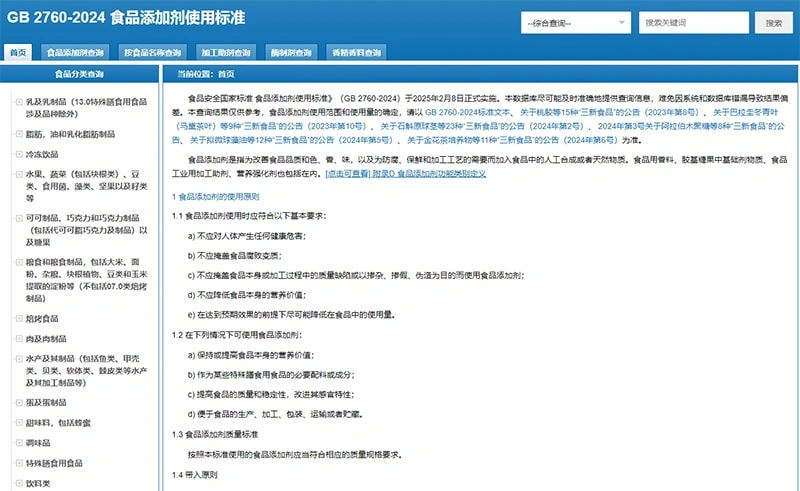The new version of the National Standard for Food Safety, Standard for the Use of Food Additives (GB 2760-2024) has been officially implemented, and the 2014 version of the standard, which has been in use for 10 years, will be abolished.
Description of Revision
Revised the definition of food additives
Food additives are synthetic or natural substances added to food to improve the quality, color, aroma and taste of food, as well as for preservation, freshness and processing needs. Flavors for food, base agent substances in gel-based confectionery, processing aids for the food industry, and nutritional enhancers are also included. Under the Food Safety Law implemented in 2015, the inclusion of nutritional enhancers was added to the definition of food additives.
Some food additive varieties and/or use regulations were revised
1. food additive varieties and their use regulations that are no longer necessary for the process after investigation, such as rambutan red, mimoun yellow, sour date color, 2,4-dichlorophenoxyacetic acid, sea loofah gum, and azocarbonamide, have been deleted;
2. deleted the use requirements of preservatives in canned food, glacial acetic acid in vinegar, natamycin in fruit and vegetable juice syrup, β-carotene and mono- and diglycerides of diacetyl tartaric acid in distilled spirits.
Revised the requirements for the use of some food additives
1. increased the total amount of aspartame, acesulfame and aspartyl phenylalanine methyl ester acetylsulfanilic acid etc. when they are used together in the same food category;
2. improved the correspondence between the use of food additives for liquid beverages and corresponding solid beverages in the category of beverages;
3. revised the requirements for the use of sulfur dioxide, carrageenan, guar gum, dehydroacetic acid and its sodium salt, etc;
4. re-categorized some food categories classified as “Others” in the original standard, and adjusted the corresponding food additive use regulations.
Revised the principles for the use of flavors and fragrances for food.
Further clarified the requirements for the use of food flavors with other food additive functions or other food uses, such as benzoic acid, cinnamaldehyde, guarana extract, sodium diacetate, disodium succinate, tricalcium phosphate, amino acids, etc.; made it clear that the labels of food flavors and fragrances for food should comply with the provisions of the “National Standard for Food Safety: General Principles for Labeling of Food Additives” (GB 29924-2013). The labeling of food spices and food flavors should comply with the provisions of the General Principles for the Labeling of Food Additives of the National Standard for Food Safety (GB 29924-2013), and prepackaged foods with added food spices and flavors should be labeled in accordance with the General Principles for the Labeling of Prepackaged Foods of the National Standard for Food Safety (GB 7718-2011). 29938-2020) and relevant spice product standards.

Revised and improved some varieties of food spices
Deleted 6 spice varieties such as Kuk Ming Oil (among them, Kuk Ming Oil and Fenugreek are already spices, Rose Eggplant, Pomegranate Juice Concentrate and Shredded Corn Cob are already common food products, and 3-Acetyl-2,5-Dimethylthiophene is no longer in use in the industry); adjusted Aniseed Brain and Root Cortex to be synthetic spices; modified and/or added the Chinese and English names, FEMA numbers, codes, etc., of such spices as Naringenin (Naringin Extract). etc.
Deleted some varieties of processing aids for food industry.
Mineral oil was deleted, and its use regulations were integrated with those of white oil (liquid paraffin); ammonium phosphate was deleted, and its use regulations were integrated with those of diammonium hydrogen phosphate and diammonium dihydrogen phosphate.
Revised some of the processing aids and/or their use regulations.
Deleted the varieties and use regulations of 1,2-dichloroethane; deleted the regulations on the use of β-cyclodextrin for pasteurized milk and sterilized milk; clarified the specific functions and scope of use of hydrogen peroxide when it is used as a processing aid.
Modified some food categories
The two categories of prepared soy sauce (Food Category No. 12.04.02) and prepared vinegar (Food Category No. 12.03.02) are classified as liquid compound seasonings (Food Category No. 12.10.03); the term “vinegar (Food Category No. 12.03)” has been amended to “vinegar (Food Category No. 12.03)”; and the term “vinegar (Food Category No. 12.03)” has been amended to “vinegar (Food Category No. 12.03)”. food category number 12.03)”; adding the food category of meatballs; deleting the food category of semi-sparkling wines; revising the food category of candied fruits; and adjusting the food category of sugar.






